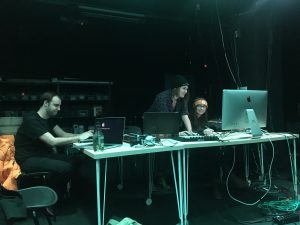
For the field recordings assignment, our group chose to first focus in on the little sounds of everyday life. We recorded small moments which might ordinarily fade into the background, but when focused in on, revealed satisfying textural experiences. Some of these were the babbling of the stream in a park, the snap of a camera, the squeak of a hand on a rail, and the droning hums of a refrigerator and stove top. Though our chosen sounds all came from very different environments, we sought to combine them into a single immersive space, leveraging the possibilities of the 8.1 system to create a soundscape that was both familiar and yet surprising. An important aspect of our approach was in changing the “scale” of the sounds as we heard them. We quickly realized that the ambisonics system would allow us to make these tiny sounds feel absolutely enormous— this would place these familiar sounds into a sonically unfamiliar space, and even make the listener feel improbably small.
We used to HOA library to create an ambisonic experience in an 8.1 speaker system. Using 8 sounds:
Fridge Hum Coin Drop A Burner Click A small Brook in Schenley
CFA Handrail A Camera Click A chip ‘CRUNCH’ Tape Ripping
We split them into two groups and ambi-sonically spun one group clockwise and one group counter-clockwise. We played the Fridge hum on all 8 speakers equally because it was such a low frequency that you were unable to pick up where it was coming from. The Video shows the way both groups rotated and changed throughout the course of the piece. video link:
The installation had a small amount of live-performance added to it. We kept the gain of each sound effect ‘Gooey’ and open to change as the piece went on based on reactions to the audience and the relative environment. The piece started by slowly increasing the gain for one sound effect, and then slowly adding more over time. The end of the piece was the slow manual fade of each sound. We did this because we wanted each experience of the installation to be unique and different.
We chose to present the piece with all of the lights (or as many as the room would allow for) turned off. This helped to further disengage the listeners from the Media Lab environment, removing nearly all visual input and thus heightening the sonic experience. Its interesting to note that the first cue of the sound piece was a lighting effect instead of an aural effect.

We uploaded our code so that anyone is able to use and open our max-patch. Max Code Link:
Group Contribution:
Kayla – Sound Recorder, Max-Patch Coder, Lighting Engineer, and Ambience Engineer.
Julian – Sound Recorder, Audio Editor, Audience Prompter, and Ambience Engineer.
Kaitlin – Sound Recorder, Performance Documenter, and Ambience Engineer.
Joey – Sound Recorder, Audio Editor, Lighting Engineer, and Ambience Engineer.